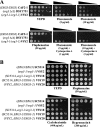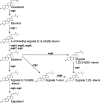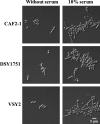Azole resistance by loss of function of the sterol Δ⁵,⁶-desaturase gene (ERG3) in Candida albicans does not necessarily decrease virulence
- PMID: 22252807
- PMCID: PMC3318373
- DOI: 10.1128/AAC.05720-11
Azole resistance by loss of function of the sterol Δ⁵,⁶-desaturase gene (ERG3) in Candida albicans does not necessarily decrease virulence
Abstract
The inactivation of ERG3, a gene encoding sterol Δ⁵,⁶-desaturase (essential for ergosterol biosynthesis), is a known mechanism of in vitro resistance to azole antifungal drugs in the human pathogen Candida albicans. ERG3 inactivation typically results in loss of filamentation and attenuated virulence in animal models of disseminated candidiasis. In this work, we identified a C. albicans clinical isolate (VSY2) with high-level resistance to azole drugs in vitro and an absence of ergosterol but normal filamentation. Sequencing of ERG3 in VSY2 revealed a double base deletion leading to a premature stop codon and thus a nonfunctional enzyme. The reversion of the double base deletion in the mutant allele (erg3-1) restored ergosterol biosynthesis and full fluconazole susceptibility in VSY2, confirming that ERG3 inactivation was the mechanism of azole resistance. Additionally, the replacement of both ERG3 alleles by erg3-1 in the wild-type strain SC5314 led to the absence of ergosterol and to fluconazole resistance without affecting filamentation. In a mouse model of disseminated candidiasis, the clinical ERG3 mutant VSY2 produced kidney fungal burdens and mouse survival comparable to those obtained with the wild-type control. Interestingly, while VSY2 was resistant to fluconazole both in vitro and in vivo, the ERG3-derived mutant of SC5314 was resistant only in vitro and was less virulent than the wild type. This suggests that VSY2 compensated for the in vivo fitness defect of ERG3 inactivation by a still unknown mechanism(s). Taken together, our results provide evidence that contrary to previous reports inactivation of ERG3 does not necessarily affect filamentation and virulence.
Figures






Similar articles
-
Loss of Upc2p-Inducible ERG3 Transcription Is Sufficient To Confer Niche-Specific Azole Resistance without Compromising Candida albicans Pathogenicity.mBio. 2018 May 22;9(3):e00225-18. doi: 10.1128/mBio.00225-18. mBio. 2018. PMID: 29789366 Free PMC article.
-
Fluconazole treatment is effective against a Candida albicans erg3/erg3 mutant in vivo despite in vitro resistance.Antimicrob Agents Chemother. 2006 Feb;50(2):580-6. doi: 10.1128/AAC.50.2.580-586.2006. Antimicrob Agents Chemother. 2006. PMID: 16436713 Free PMC article.
-
Inactivation of sterol Delta5,6-desaturase attenuates virulence in Candida albicans.Antimicrob Agents Chemother. 2005 Sep;49(9):3646-51. doi: 10.1128/AAC.49.9.3646-3651.2005. Antimicrob Agents Chemother. 2005. PMID: 16127034 Free PMC article.
-
[Azole resistance in Candida spp].Nihon Ishinkin Gakkai Zasshi. 2003;44(2):87-92. doi: 10.3314/jjmm.44.87. Nihon Ishinkin Gakkai Zasshi. 2003. PMID: 12748589 Review. Japanese.
-
Candida and candidaemia. Susceptibility and epidemiology.Dan Med J. 2013 Nov;60(11):B4698. Dan Med J. 2013. PMID: 24192246 Review.
Cited by
-
Genomic Variation-Mediating Fluconazole Resistance in Yeast.Biomolecules. 2022 Jun 17;12(6):845. doi: 10.3390/biom12060845. Biomolecules. 2022. PMID: 35740970 Free PMC article. Review.
-
Combination of Estrogen and Immunosuppressive Agents to Establish a Mouse Model of Candidiasis with Concurrent Oral and Vaginal Mucosal Infection.Mycopathologia. 2016 Feb;181(1-2):29-39. doi: 10.1007/s11046-015-9947-5. Epub 2015 Sep 24. Mycopathologia. 2016. PMID: 26404163
-
Phenotypic plasticity and the evolution of azole resistance in Aspergillus fumigatus; an expression profile of clinical isolates upon exposure to itraconazole.BMC Genomics. 2019 Jan 9;20(1):28. doi: 10.1186/s12864-018-5255-z. BMC Genomics. 2019. PMID: 30626317 Free PMC article.
-
The development of fluconazole resistance in Candida albicans - an example of microevolution of a fungal pathogen.J Microbiol. 2016 Mar;54(3):192-201. doi: 10.1007/s12275-016-5628-4. Epub 2016 Feb 27. J Microbiol. 2016. PMID: 26920879 Review.
-
Molecular mechanisms of drug resistance in clinical Candida species isolated from Tunisian hospitals.Antimicrob Agents Chemother. 2013 Jul;57(7):3182-93. doi: 10.1128/AAC.00555-13. Epub 2013 Apr 29. Antimicrob Agents Chemother. 2013. PMID: 23629718 Free PMC article.
References
-
- Abe F, Usui K, Hiraki T. 2009. Fluconazole modulates membrane rigidity, heterogeneity, and water penetration into the plasma membrane in Saccharomyces cerevisiae. Biochemistry 48:8494–8504 - PubMed
-
- Bard M, et al. 2005. Sterol uptake in Candida glabrata: rescue of sterol auxotrophic strains. Diagn. Microbiol. Infect. Dis. 52:285–293 - PubMed
Publication types
MeSH terms
Substances
LinkOut - more resources
Full Text Sources

